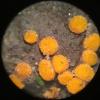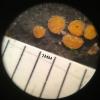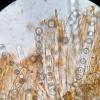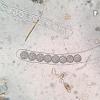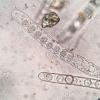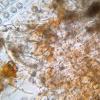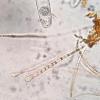
20-12-2025 23:08
Patrice TANCHAUDBonsoir, récolte sur sol sablonneux dans l'arri�

21-12-2025 09:32
Hello.A tiny ascomycete found embedded in wood in

20-12-2025 15:47
Mirek GrycHi.These grew on pine wood that was heavily covere

18-12-2025 21:17
Pol DebaenstThe identification took me to Byssonectria deformi

15-12-2025 07:09
 Danny Newman
Danny Newman
indet. Rutstroemiaceae sp. on unk. fallen leavesMc

19-12-2025 10:10
Patrice TANCHAUDBonjour, récolte réalisée en milieu dunaire, a

18-12-2025 17:23
 Bruno Coué
Bruno Coué
Bonjour,je serais heureux d'avoir votre avis sur c
Asci are about 232-297 by 17-24µm and IKI-.
Spores in asci appear in 3 forms. 1. Smaller, thick walled, hyaline, globose and multi-guttulate. 2. More or less the same as above but wrapped in a gelatinous sheathe, and 3. larger globose, hyaline ascospores with spines. I assumed that the spores ornamented with spines were the mature ascospores and measured those: 20-21 by 20-21µm. The spines are as long as 2.5 µm.
Excipulum appears to be textura angularis. Paraphyses have orange contents and are slightly swollen at the tips to a width of about 7.5µm.
Is this Ramsbottomia crechqueraultii? I have noticed that many online resources (Indexfungorum etc.) retain this species in Lamprospora. Any opinions are welcome!
Thanks in advance.
Ethan

Benkert & Schumacher (1985, Agarica 6(12): 28-46) stated in their emendation that the genus Ramsbottomia differs from Lamprospora in not being bryoparasitic, having ectal excipulum of t. globulosa or globuulosa-angularis, and having smooth margin (not crenulate / frayed like Lamprospora). I don't know if there are any molecular data on the Ramsbottomia-Lamprospora relationship.
There should be short and thick thin-walled hyphoid hairs on the receptacle, either hyaline or light brown. If the latter, you might compare R. lamprosporoidea too (if you acknowledge it as good species and not a synonym of R. asperior). I haven't seen yet the spore sheath to survive to their maturity, usually it disappears sooner. Some Scutellinias have similar one - S. trechispora or legaliae.
It's a very nice genus, I'm always glad when I find it, but I think it needs some molecular work to clarify how many species there actually are (2, 3, or 4, in different authors' concepts) and how to distinguish asperior from crechqueraultii (is the primary character ornamentation height or less globose shape?).
Viktorie
Best wishes,
Gernot

